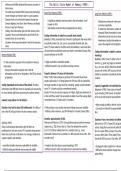- Atkinson and Shiffrin believed the memory consists of The Multi Store Model of Memory (MSM):
three stores.
- The Multi-store Model (MSM) claims that information Short Term Memory (STM) : Long Term Memory (LTM) :
travels through our memory store in a set sequence.
- Stimulus from our environment passes through our - If significant attention has been paid to the information, it will - Maintenance rehearsal= when we re
Sensory Register, then Short Term Memory and finally transfer to STM. ourselves repeatedly.
into our Long Term Memory. - Information can be lost due to displacement or decay. -
- If material is rehearsed a number of
Coding= how information gets into the memory store
- rehearsal) then information is transf
Capacity= How much information can be held in the Coding: Information is coded in an acoustic form (sound.) - Information can be lost due to decay
memory store at any one time. Baddeley (1966): presented lists of words to participants that were either
- interference (similar information ent
Duration= How long information is held in the memory acoustically similar (cat, cab, can) or acoustically dissimilar (pit, few, causes the original to be forgotten o
store. lamb.) P’s were asked to recall the words immediately. It was found that
the words that sounded the same were hard to remember because they Coding: Information is coded in a seman
Sensory Register (SR) : caused confusion in the STM. meaning.)
Baddeley (1966): Gave P’s either a list of
- It’s the automatic response to the reception of sensory + highly controlled/ controlled variable words (e.g., great, big, huge) or semantic
information - Artificial research/ may not reflect everyday memory (e.g., run, easy, bright.) Recall was tested
- Sensory information originally enters the SR accuracy for similar, 85% accuracy for dis
- Information can be lost or forgotten in the SR due to lack Capacity: Between 5-9 pieces of information harder to remember semantically similar
of attention. Miller (1956): Meta-analysis on previous STM research found most created.
people could retain 7+-2 things before the STM was full. He named this
Coding: dependant on the sense of the stimuli. SR codes the magic number. He also found by ‘chunking,’ people could remember Capacity: Suggested to be unlimited (no
information into different stores for example ionic processing more (7+-2 chunks could be remembered instead.) Wagenaar (1986): Case study on himself.
for visual stimuli and Echoic processing for auditory stimuli. Jacobs: P’s have to read out sequence of 4 digits. Digits are added one at years including 2,400 events. He tested h
a time until they couldn’t be accurately recalled. Found the average digits of his recall and found he had excellent re
Capacity: Large (about ¾ of all stimuli.) remembered was 7.3 letters and 9.3 numbers.
+ High ecological validity, reflects ‘real me
Duration: Very brief at about 500 milliseconds. Very little of + Meta-analysis, many studies had same findings increases reliability - Case study on himself, low generalisabil
info in the SR will pass further into the memory system. - Artificial, other evidence says STM limited to 4 chunks (Cowan 2001) bias
Duration: approximately 18-30s Duration: From a few minutes to infinite
Sperling (1960): Peterson and Peterson (1959): Using tachistoscope presented nonsense Bahrick et al (1975): Tested 392 old gradu
Using a tachistoscope presented a grid of letters to trigrams (e.g., TQL) for less that 1s. They then delayed the recall for school. Using their year book he asked th
participants for only one second. P’s reported seeing several 3,6,9,12,15,18s by making them do a separate task (e.g., count face to a name (90% accuracy 15yrs after
letters but could only recall about 4 on average. Evidence to backwards in threes from a number.) 3s= 80% accurate recall. 18s= .10% accuracy 48yrs after.) Then asked if they c
support capacity and duration. accurate recall the photo (60% accuracy 15yrs after, 30%
+ controlled variables increases replicability & reliability + Insight to idea that decay causes forgetting in STM + Ecologically valid, insight into ‘real mem
- Artificial setting and stimuli reduces external validity - Artificial, doesn’t reflect everyday memory (low external validity.) - Difficult to know whether changes due t
aging effects
, Evaluating the MSM:
Serial position curve supports the MSM: Glanzer & Cunitz (1966) show
participants a list words. They then had to recall as many words they cou
in any order. Findings showed a serial position curve. Primacy effect: The
on the list are remembered by many. This is because they have been rep
participants head, transferring it to LTM for recall. Recency effect: The la
the list are recalled by many. This is because, with a duration of 18-30s,
still in P’s STM. Supports MSM that memory is split into different stores.
Case studies to support. ‘HM’ had good LTM for event before his accide
it, cannot create new memories. This is because he is unable to transfer
from STM to LTM. Clive Wearing still has SR and STM but no LTM. Shows
different memory stores (STM & LTM.)
Research under artificial conditions: Research to support serial position curve conducted
artificial tasks (e.., memorising word lists.) Low ecological validity as may not reflect how
used daily to process everyday information. Difficult to generalise findings to public to sup
MSM too simplistic. Tulving argued MSM too simple to explain LTM as one store. Argued
episodic, semantic and procedural long-term memories. Supported by inconsistencies in t
of Clive Wearing. Still remembers how to play music and his wife’s name. HM could still im
procedural tasks despite no recollection of taking part in them. Implies LTM memory mus
complex.




